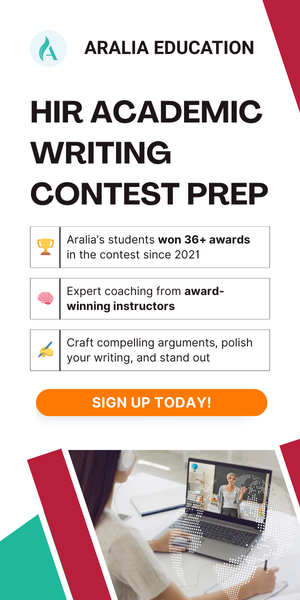Enhance Your Research Skills with Aralia’s Research Scholar Classes
1. What is a research paper?
Before going into the individual steps, you need to understand what a research paper is to understand the purpose of it. A research paper is a piece of academic writing that provides an in-depth explanation on a specific topic of your choice, providing evidence and citations for your sources and proving that critical research was conducted. The purpose of research papers is to effectively share information with everyone who is interested in the topic, whether it is for their indulgent reading or to be used as a piece of evidence for their research topic. It is one of the pillars in the academic world that contributes greatly to discoveries in modern science today. Without research papers, a researcher would find it difficult to find backing evidence for their goal, whether working to discover a new cure to a disease or building new technology.
2. How many parts are in a research paper?
A research paper consists of about 6 parts and is as follows:
- Abstract: a short summary of the entire paper with important key parts being highlighted, the thesis which the research you are conducting is based on, the results of actions taken, and your conclusion or any other opinions you’ve developed during the research.
- Introduction: The introduction is where you would discuss your thesis statement, a statement that clearly states your standpoint on a specific topic you are researching, why you are conducting the research to prove your point, and any important background information.
- Methods and/or experiments: this part of the paper is where most of the work is done. Any experiments, equipment, strategies, breakdown of the steps taken, design, variables, and research would be kept as a record here. This section of the paper should provide in-depth details so that any researcher with adequate experience could re-create the same experiment or analyze the research. All of these must be relevant to the thesis on which you are conducting the research.
- Results: in this section, describe the results of all the completed work. You will often present some of your results using figures, tables, graphs, or images.
- Discussion: any additional opinions or questions that have arisen or been answered during the whole process will be disclosed here. Whether or not the experience supported or went against your thesis, any other ideas that could be used to further the research, or perhaps the formation of a new thesis altogether.
- References: The references section is where you cite all of the sources you’ve used to conduct your research.
Now that we have explained what a research paper is and its parts, we can unlock the secrets to writing a proper research paper in six steps.
3. How to Write a Research Paper In 6 Steps
The first step is to choose a topic you are interested in so that you can conduct thorough research about which you are passionately curious. The topic can be any topic in which you want to have questions answered. It may seem simple, but this step is extremely important because it will shape the rest of your paper and research. Generally, you want to choose a topic which you can have a lengthy discussion about. The research, experiments, and methods must provide enough data and complexity to generate a great discussion.
The second step is conducting preliminary or background research for your chosen topic. Utilizing keywords or phrases, find an ample amount of resources that support your idea. Resources such as articles, books, other research papers, and reliable internet sources are a great way to begin the initial research part of your paper. The article “5 Steps in Research Process” on Aralia is a great reference. It gives a breakdown of how to conduct proper research and great examples of how to structure it. Once you’ve conducted your initial research, analyze all the resources you’ve found and authenticate their reliability. Usually, you want to do this step before conducting your actual research. From there, you form a thesis statement, which is step three.
The thesis statement, step three, summarizes the topic you are trying to prove that is correct or incorrect. Clearly state your position in this argument and briefly share how your research supports or does not support this. This is the pinnacle of all the research that you’ve done and the conclusion you’ve come to.
Aralia Students Are 4x More Likely to Publish a Research Paper
The next two steps are the most exciting part of the paper– the ideas of all your extensive research come to life on paper! The fourth step is to develop the skeleton or the outline of the paper. This is the barebones of your paper, where you put in key topics, a brief summary of the research conducted, experiments, important thoughts, opinions, and highlighted points that will be evaluated in the first draft. Generally, the outline does not have to be written in complete sentences, just ideas that you would like to talk about during that specific section of the paper. It allows you to be able to see how it all flows together, and move topics around if you feel like it does not make sense before you commit to writing a full 4,000-5,000 word paper.
Finally, once the blueprint of your research paper is laid out and it all makes sense, you can begin to formulate your effort into complete sentences and see how it all comes together. Be aware that this is only your first draft, so there will be parts that you want to change later; however, the editing can come after you’ve gotten all of your ideas on paper and read them to yourself so that they can be understood because this research paper is meant for others to be able to understand from a reader’s point of view. From there, you can edit and revise what you feel is necessary to make your paper flow, it could be to simplify some parts, it could be to omit some information that you deemed unnecessary in the process of writing the first draft, or add any new information that you found as new ideas had come up.
Lastly, cite your sources, because this section gives your work credibility! It is probably the simplest part but is an extremely crucial portion of your research paper. This is done in alphabetical order, and anyone should come to the same or similar conclusion if they were to go to these sources and conduct the same research for themselves.
If you’re ready to write but need some inspiration, here is Research Paper Examples for High School Students.
4. Create Your Research Paper With Aralia
Aralia Education offers a range of research opportunities for high school students, including mentorship programs and research projects. These programs are designed to help students develop their research skills and produce high-quality research papers. Consider participating in these to learn essential skills and prepare yourself to write research papers for competitions, college, and beyond!










